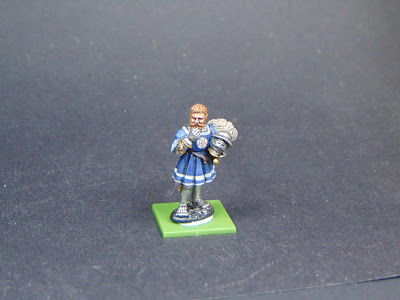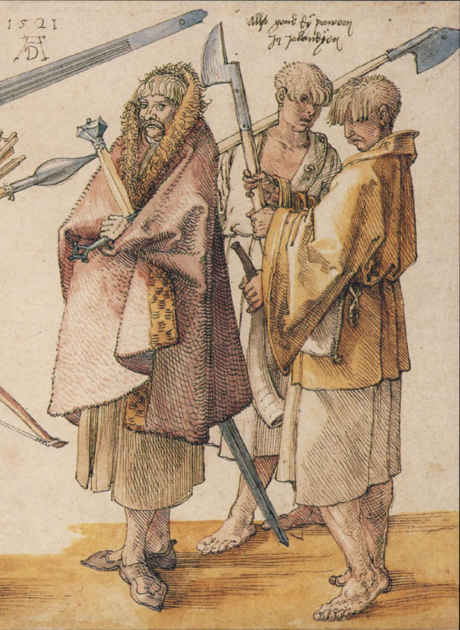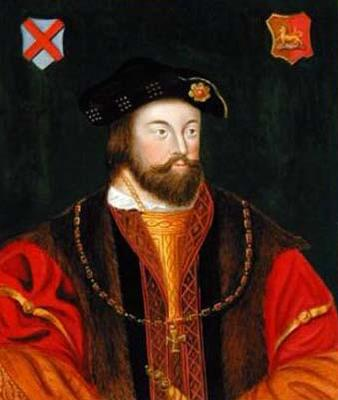Hi again!
Another Renaissance Irish update! This time I wanted to attempt some figures to represent some Irish commanders on horseback, particularly with Never Mind the Billhooks' Deluxe edition giving rules for Irish cavalry!
Unfortunately finding miniatures to represent late-medieval/renaissance Irish cavalry
and having them scale properly in 28mm with the Perry Irish range is pretty difficult! Which meant going in to this would need some thought about converting existing figures to look the part of both an Irish Earl and his mailed standard bearer
Choosing figures as bases to start the conversions was a bit of a task! I'm not hugely confident in my sculpting abilities, so I wanted to try to focus on a few key points to have the figures at least be visually recognisable without necessarily needing me to sculpt on large areas of mail or detailed clothes.
For the Earl, I visually based his appearance on the "Irish Chieftain" depicted in a few of the woodcuts in The Image of Irelande. It is worth pointing out that the book is very much a piece of Tudor English propaganda, intending to demonise the Irish and promote the English forces in Ireland, so it should be taken with a grain of salt! But in the absence of many other sources, it made for a good start
In these images, the chieftain has an interesting segmented helmet (with a plume), so that was something I definitely wanted to include. He's also wearing an interesting outfit, initially I thought it was some sort of brigandine or studded jack, but it seems to be more consistent with civilian doublets in other 16th century portraits rather than any kind of armour. Finally, as shown in the first image, the chief has a very impressive cloak (or brat), with a thick fur-like fringe, which was another definite requirement for me to include!
For the Brat, the
Gaelic Attire Website provides a very useful explanation of its construction, and some great reproductions (which have made great reference images!). The fringes themselves appear to have been made of wool (occasionally styled to
look like fur), and for the wealthy this would have been dyed in a variety of colours
With that in mind as a design direction, I decided to use one of the Perry Sudanese commanders as a base figure, given his pose, and his excellent cloak to make a base for the brat:
And from there, I gave him a head-swap for one of the Gallowglass figures to try and match the interesting helmet shown in the woodcuts, and added a plume to it. Then, with some filing down of the body and legs, I sculpted on a Tudor doublet and boots, and then added a fringe to the cloak to convert it into an Irish Brat
In terms of colours, I went with a copy of the Brat in Dürer's depiction of Gallowglass in the early 16th century, with the cloak itself being a deep red/maroon/pink, and the fringe being a bright yellow
The standard bearer was a bit of a simpler conversion, seeing as my design philosophy for him was more straightforward. I wanted him to essentially look like a mounted Gallowglass, so the rider was based on a Victrix Norman, with his head swapped for one of the Perry Gallowglass, and a The Assault Group targe added in place of the Norman shield.
The horse was a little more involved, seeing as the Irish cavalry of the 16th century notably did not use stirrups or saddles, instead opting for what appears to be more of a cushion strapped to the horse. Given that information, I trimmed the saddle off of the horse, and used green stuff to sculpt on the quilted cushion (which helped mask the width difference between the Victrix legs and the Perry horse too!)
And finally to round off the whole base, I added an Irish wolfhound from Footsore Miniatures
Currently I only have flags for Kildare and Desmond put together, but the standard bearer's flags are detachable, so they can be easily swapped out for any other Gaelic or Anglo-Irish lords (once I get the flags made!)
And here's the Earl of Kildare riding alongside a band of kern
Hopefully they've turned out ok! The plan is to work on some cavalry to accompany the Earl on the field next!













































